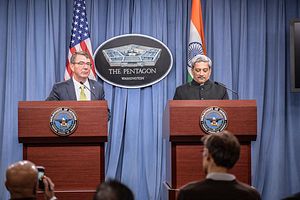U.S. Defense Secretary Ashton Carter is heading to India next week. While in New Delhi, he’ll meet with his Indian counterpart, Manohar Parrikar, and the two will exchange views on a range of issues affecting their bilateral defense cooperation and on broader issues of interest in the Asia-Pacific region. Three bilateral defense agreements will be high on the agenda during Carter’s visit: the Communication and Information Security Memorandum of Agreement (CISMOA), the Basic Exchange and Cooperation Agreement (BECA), and—perhaps the most consequential of the three—the Logistics Supply Agreement (LSA).
Each of these agreements expands U.S.-India defense cooperation in a fairly modest manner, without necessitating a revolution in either side’s approach to the partnership. India’s approach to the United States remains limited in important ways, despite the fact that New Delhi increasingly purchases more arms than ever from U.S. suppliers and conducts more military exercises with the U.S. military than any other country’s armed forces. Since Indian Prime Minister Narendra Modi was elected in 2014, India and the United States have made some important forays on defense cooperation. (For more on this, see my takeaways from Modi’s September 2014 visit to the United States and Obama’s January 2015 visit to India.)
Truth be told, LSA, CISMOA, and BECA aren’t particularly exciting agreements. Certainly, none of them represent anything revolutionary. Instead, they are the foundational building blocks for a deeper U.S.-India defense partnership. The LSA—the most talked about of the three agreements—would set a framework for the two countries to share military logistics. Under the reciprocal agreement, both New Delhi and Washington would have the ability, but not the obligation, to assist each other’s armed forces with simple military logistics. For the U.S. Navy, for example, logistics support from India would be a valuable asset, helping it better project power in the Indian Ocean.
CISMOA, meanwhile, would allow the United States to supply India with its proprietary encrypted communications equipment and systems, allowing secure peacetime and wartime communication between high-level military leaders on both sides. CISMOA would extend this capability to Indian and U.S. military assets, including aircraft and ships. Finally, BECA would set a framework through which the United States could share sensitive data to aid targeting and navigation with India.
There’s clear momentum in U.S.-India defense ties in the Obama administration’s final year. Last year’s renewal of the U.S.-India defense framework for another decade, combined with continued technology cooperation under the Defense Technology and Trade Initiative (DTTI), has invigorated bilateral defense cooperation. Carter, in December, described the U.S.-India defense partnership as an “anchor of global security.” Moreover, as I discussed recently, the United States is increasingly taking the lead in this dance, asking New Delhi to move faster on some issues than it may be comfortable, such as joint patrols in the Indian Ocean and South China Sea.
India has already agreed to the these three agreements “in principle,” but the alphabet soup of LSA, CISMOA, and BECA has spurred much debate in New Delhi, bringing up familiar arguments that have prevented U.S.-India military convergence in the past. For instance, anxieties persist in New Delhi that signing these agreements could erode India’s military independence; erode its historically close security relationship with Russia, jeopardizing ongoing projects; antagonize China, leaving India in a disadvantageous position vis-a-vis its border disputes with Beijing; and, in the case of CISMOA, allow the United States undue insight into Indian operational practices.
From the perspective of the United States, apart from the modest technical benefits of closer cooperation with New Delhi, these agreements are largely about building a foundation of trust. In this way, they are similar to the 2002 General Security of Military Information Agreement (GSOMIA), which, according to then-U.S. Defense Secretary Donald Rumsfeld “[paved] the way for greater technology cooperation” between the two sides. Like GSOMIA, which ultimately enabled the Obama administration-era DTTI, LSA, CISMOA, and BECA would open new doors for the United States and India down the line.
Defense cooperation between India and the United States has long been bounded by New Delhi’s apprehension about Washington’s intentions and LSA, CISMOA, and BECA would signal the start of a new era, coinciding with the recently updated U.S.-India defense framework. These agreements might not be concluded during Carter’s visit to India next week, but they’ll remain at the top of his agenda and of the U.S.-India defense agenda until they’re signed—or set aside in an acknowledgment of the enduring limits to this bilateral.
(Though I don’t get into it much here, the debate on the value of these agreements for India is worth a read. Pratap Bhanu Mehta and Bharat Karnad lean against these agreements; Dhruva Jaishankar offers a case in favor.)

































